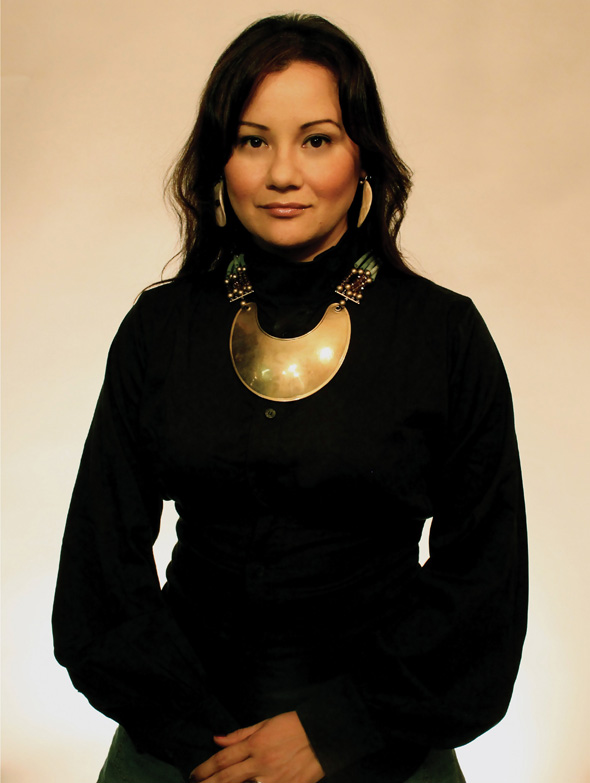Art to Adorn

Detailed, exhaustive, complex or any other single term used to describe the profoundly intricate beadwork that adorns designer Jamie Okuma’s shoes, handbags, accessories and garments feels just a little inadequate. Her bold aesthetic, which is steeped in Native American culture, comes from her formative years as a child, when she attended annual pow-wows with her grandmother at the Fort Hall Indian Reservation in Idaho. Taking in the traditions of dance and music at the pow-wows meant she required something appropriate to wear and Okuma began creating extravagantly beaded clothes suitable for the occasion. Her mother, who is also an artist, actively kept Okuma surrounded by the world of art, often taking her to gallery showings and art exhibits. Okuma’s creative pursuits lead to her own exhibit by age eighteen. Now residing on a reservation in La Jolla, Okuma continues to maintain her heritage, providing us with an established collection of wearable art that might leave its possessor conflicted with the notion of actually wearing such dazzling pieces. To answer this question, and a few others, we sat down with the exceptional artist herself and the enlightening discussion left nothing to be desired.
Your artistic career began very early. Does the accomplishment of your current work reflect much of the style you began with, or have you completely evolved since that time?
I would say both. The very first beaded piece (which I still have) was based on traditional designs, which I still do today. The evolution is in the direction of my work and the modernization of traditional designs. What started out as a necessity for being able to dance at pow-wows as a child turned into a career in art. My first pieces and what I had continued to do for about 12 years was the mix-media sculptures. They are, in an essence, miniature people. So I moved from making miniature native clothing to actual native inspired ready-to-wear and couture pieces.
There are many natural influences and materials used in your pieces, such as animal hides and shearling. What are your sources for these materials?
Detail and quality are the two elements I obsess about most. When working leather or shearling it has to be Italian, which I get from Italy. I have yet to see any better. My native pieces (beadwork) are always native brain-tanned buckskin that is used to bead on. It is the gold standard in Native American attire and base for beadwork. And in particular my brain-tanned buckskin comes from my grandmothers reservation, Fort Hall in Idaho. The beads I use are mostly antique seed beads from France, Italy and Czechoslovakia.
In elaborate works such as in your Art to Carry collection, are these intended for use in an everyday fashion or should these be viewed and respected for their aesthetic value?
Honestly it is for both intentions and always has been according to my collectors. It is what I have been told they love about my work. It is truly wearable art and the bags specifically are made to be used, and then can be displayed as an art piece.


For whom do you create your work? Who is it you envision will wear your product as you create it?
First and foremost I create for myself and what I love. If I didn’t, how could I expect anyone else to love and care for it as I do? The person who wears my pieces is a lover of life, culture, and diversity. They are unafraid to make a statement and be noticed.
With something as detailed as your floral beaded scarf, what is the production process like for executing such intricacy?
The floral “beaded” scarf is a digitally printed image on 100% silk from a fully beaded cradleboard, which took a full six months to complete. It is beaded on brain tanned buckskin and wool using antique seed beads, brass beads, trade beads and elk ivory. It is currently on view at the San Diego Women’s museum though November.
Tell me about your childhood experiences on the reservation and attending the pow-wow’s that inspired your journey as a designer.
I was born in Los Angeles and lived there until I was five years old when my parents decided to relocate to the reservation to raise me there. As much as I missed LA as a kid (and still do) I would not have had it any other way. I love my reservation and the freedom I had to run around as a kid was priceless. Being apart of a tribe and living around family is truly a unique experience unto its self.
Tell me about the Nomad Two Worlds art collaboration with Russell James.
It was so refreshing to be involved in a project backed by non-natives who wanted an authentic Native American view – not their version of what they thought a Native American’s view is. Rarely does this happen, so when I was asked to join there was no question. I was given total artistic freedom to do and say whatever I wanted and I will forever be grateful to Russell James and Nomad Two Worlds for that opportunity.
In what direction do you envision your work moving aesthetically?
My current work is fairly “new” as it is so I’m hoping to keep on this same track for the moment. It has a lot of momentum and has had a really great response from viewers.
Text by Jennifer Moulaison
Photography by Cameron Linton

